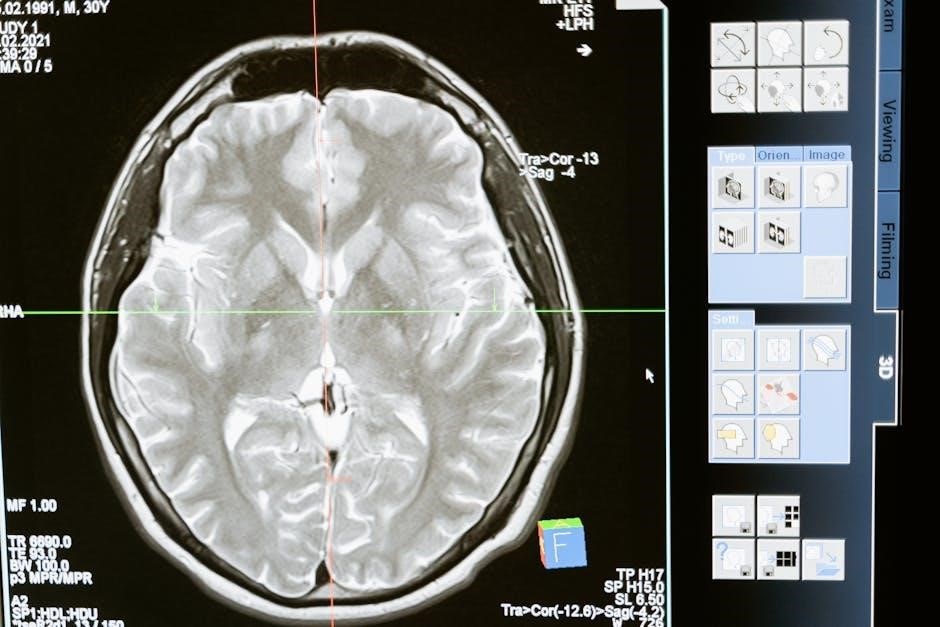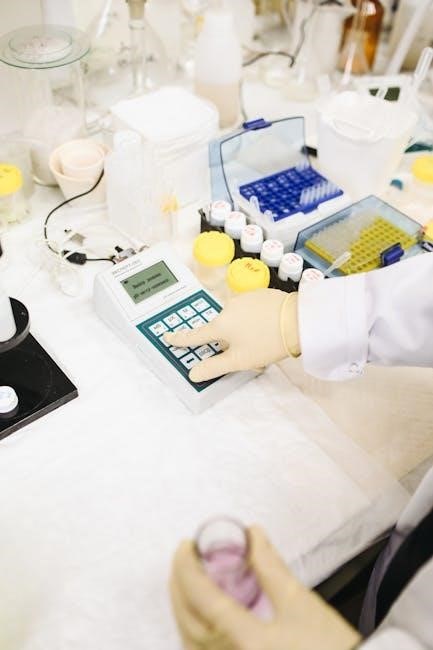An STD Test Results PDF provides a detailed and organized summary of your sexually transmitted disease testing outcomes. It includes clear interpretations of positive or negative results, explaining what they mean for your health and next steps. This document ensures confidentiality and serves as a reliable reference for understanding your sexual health status, helping you make informed decisions about treatment and prevention. It is a crucial tool for maintaining transparency and accuracy in STD diagnosis and management;
Importance of Understanding STD Test Results
Understanding STD test results is crucial for maintaining sexual health and preventing complications. Accurate interpretation ensures proper treatment, reduces the risk of long-term health issues, and minimizes the spread of infections. Knowing your status allows for informed decision-making about care and prevention strategies. It also helps avoid misinterpretation of results, which can lead to unnecessary anxiety or delayed treatment. Timely understanding of results enables early intervention, improving outcomes and quality of life. Additionally, it fosters open communication with healthcare providers and partners, promoting transparency and trust. Confidentiality and secure handling of results are emphasized to protect patient privacy and ensure accurate medical guidance. Proper comprehension of STD test results is vital for effective management and overall well-being.
Overview of STD Testing and Results
STD testing involves various methods to detect infections like chlamydia, gonorrhea, syphilis, and HIV. Common tests include blood, urine, swab, and PCR/LCR analyses. Results are categorized as positive or negative, indicating the presence or absence of an infection. Timely and accurate testing is essential for early diagnosis and treatment, preventing long-term health complications. Test results are typically detailed in a PDF format, providing clear interpretations and recommendations. This structured approach ensures clarity and confidentiality, aiding in informed decision-making. Understanding the testing process and result interpretation empowers individuals to take control of their sexual health effectively. Regular testing is recommended for sexually active individuals to maintain awareness of their status and promote public health. Early detection through reliable testing methods is key to managing and preventing STDs.

Common STDs Tested For
Common STDs tested include Chlamydia, Gonorrhea, Syphilis, Trichomonas, HIV, Hepatitis B, and Herpes Simplex Virus. These infections are frequently screened for in STD testing to ensure early detection and treatment.
Chlamydia (C. trachomatis)
Chlamydia, caused by the bacterium Chlamydia trachomatis, is one of the most common sexually transmitted infections (STIs). It can infect the genital tract, mouth, and anus, often causing asymptomatic infections. If left untreated, Chlamydia can lead to serious health complications, such as pelvic inflammatory disease (PID) in women and epididymitis in men. Testing typically involves urine samples, swabs, or advanced PCR/LCR (polymerase chain reaction/ligase chain reaction) methods for accurate detection. Early diagnosis is crucial to prevent long-term health issues and transmission to partners. Understanding test results is essential for initiating appropriate treatment, usually involving antibiotics, and ensuring timely care to avoid complications. Chlamydia testing is a key component of comprehensive sexual health screening.
Gonorrhea (N. gonorrheae)
Gonorrhea, caused by the bacterium Neisseria gonorrheae, is a highly contagious sexually transmitted infection affecting the genital tract, throat, and rectum. It often presents with symptoms such as abnormal discharge, pain during urination, or bleeding between periods in women. However, many infections are asymptomatic, emphasizing the need for regular screening. Testing methods include urine tests, swabs, and PCR/LCR techniques for accurate detection. If left untreated, gonorrhea can lead to severe complications like pelvic inflammatory disease (PID), infertility, and increased risk of HIV transmission. Understanding test results is critical for initiating antibiotic treatment and preventing further complications. Gonorrhea testing is a vital part of sexual health care, ensuring early diagnosis and effective management to reduce transmission and long-term health impacts.
Syphilis (Treponema pallidum)
Syphilis, caused by the bacterium Treponema pallidum, is a sexually transmitted infection that progresses through distinct stages if untreated. Early symptoms include painless sores, followed by a rash and flu-like symptoms. Testing typically involves blood tests or direct visualization of the bacteria under a microscope. Positive results are interpreted using non-treponemal and treponemal tests, which differentiate between past and current infections. Timely diagnosis is crucial, as untreated syphilis can lead to serious complications, including neurological issues and congenital syphilis in newborns. Understanding test results ensures appropriate treatment, usually with penicillin, and prevents long-term health consequences. Regular screening is recommended for high-risk individuals to control the spread and manage infections effectively.
Trichomonas (T. vaginalis)
Trichomonas vaginalis is a common sexually transmitted parasite causing trichomoniasis. Symptoms include vaginal itching, abnormal discharge, and irritation in both men and women. Testing often involves wet mount microscopy, PCR, or antigen detection for accurate diagnosis. Positive results confirm the presence of the parasite, necessitating treatment with antiprotozoal medications like metronidazole. Early diagnosis is critical to prevent complications such as pelvic inflammatory disease and increased risk of HIV transmission. Understanding test results ensures proper treatment and reduces the likelihood of spreading the infection. Regular screening is advised for sexually active individuals, especially those with multiple partners, to maintain sexual health and prevent long-term complications. Timely interpretation of results is essential for effective management and recovery.
HIV
HIV testing is a critical component of STD screenings, typically conducted through blood tests that detect antibodies or viral RNA. Results are categorized as positive, negative, or inconclusive. A positive result indicates the presence of HIV, while a negative result suggests no infection. It’s important to note that testing positive for HIV does not mean you have AIDS, as HIV progresses to AIDS over time if untreated. Understanding your HIV status is vital for preventing transmission and managing your health. Early detection allows for timely antiretroviral therapy (ART) to suppress the virus. Confidentiality and secure handling of HIV test results are paramount to protect patient privacy. Regular testing is recommended for sexually active individuals, especially those at higher risk, to ensure early intervention and better health outcomes.
Hepatitis B
Hepatitis B is a viral infection that can be transmitted through sexual contact, and its testing is a key part of STD screenings. Blood tests detect specific antigens and antibodies to determine infection status. A positive result for the hepatitis B surface antigen (HBsAg) indicates an active infection, while the presence of antibodies (anti-HBc or anti-HBs) may signify immunity or past infection. Understanding these results is crucial for managing your health and preventing further transmission. If positive, consulting a healthcare provider for further evaluation and potential treatment is essential. Timely interpretation and confidentiality of Hepatitis B test results are vital to ensure appropriate care and protect patient privacy. Regular testing is recommended for sexually active individuals at higher risk of exposure.
Herpes Simplex Virus (HSV)
Herpes Simplex Virus (HSV) is a common sexually transmitted infection, with two main types: HSV-1 and HSV-2. HSV-1 typically causes oral herpes, while HSV-2 is primarily associated with genital herpes. Transmission occurs through direct skin-to-skin contact, often during sexual activity. Symptoms may include painful blisters or sores, though many individuals remain asymptomatic. Testing for HSV involves swabs of active lesions or blood tests to detect antibodies. Positive results indicate current or past infection, and blood tests can differentiate between HSV-1 and HSV-2. Understanding HSV test results is crucial for managing symptoms, preventing transmission, and receiving appropriate care. Timely interpretation and confidentiality of these results are essential for effective patient management and public health efforts. Regular testing is recommended for individuals at higher risk of exposure to ensure early diagnosis and treatment.

Types of STD Tests
STD tests include blood tests, urine tests, swab tests, and PCR/LCR tests to detect infections like HIV, chlamydia, gonorrhea, syphilis, and herpes, ensuring accurate diagnosis and timely care.
Blood Tests for HIV, Hepatitis B, and Syphilis
Blood tests are a common method for diagnosing HIV, hepatitis B, and syphilis. These tests detect antibodies or antigens in the blood, indicating exposure to the pathogens. For HIV, blood tests measure antibodies and p24 antigens, while hepatitis B tests identify surface antigens (HBsAg) and antibodies (anti-HBs). Syphilis blood tests, such as the Rapid Plasma Reagin (RPR) and Treponema Pallidum Particle Agglutination (TPPA), detect antibodies against Treponema pallidum. Results are typically available within a few days to weeks, depending on the lab. Blood tests are highly accurate and essential for early detection, enabling timely treatment and preventing complications. Confidentiality is maintained throughout the process, ensuring patient privacy and trust in the testing system.

Urine Tests for Chlamydia and Gonorrhea
Urine tests for chlamydia and gonorrhea are non-invasive and widely used for screening. These tests detect the genetic material (DNA) of the bacteria in urine samples, providing accurate results. They are particularly useful for asymptomatic individuals and can be conducted in clinical or at-home settings. For men, urine tests are reliable for diagnosing gonorrhea, while for women, they are often combined with swabs for higher accuracy. Positive results for gonorrhea may require confirmation due to the risk of false positives. Urine tests are quick, convenient, and reduce the need for invasive procedures, making them a preferred method for early detection and treatment of these STDs. Regular screening is crucial for preventing complications and transmission.
Swab Tests for Chlamydia and Gonorrhea
Swab tests for chlamydia and gonorrhea involve collecting cells from the affected area using a cotton swab. For women, swabs are typically taken from the cervix, while men may have swabs from the urethra. These tests are highly accurate for detecting infections and are often used in combination with urine tests for comprehensive screening. Swab tests can cause mild discomfort but are essential for diagnosing infections in symptomatic individuals. They are particularly recommended for women, as they provide more reliable results than urine tests alone. Swab samples are sent to a lab for analysis, and results are typically available within a few days. This method ensures accurate diagnosis, enabling timely treatment and preventing complications. Swab tests remain a critical tool in STD detection and management.
PCR/LCR Tests for Chlamydia and Gonorrhea
PCR (Polymerase Chain Reaction) and LCR (Ligase Chain Reaction) tests are nucleic acid amplification methods used to detect chlamydia and gonorrhea infections. These tests identify the genetic material of the bacteria, providing high sensitivity and specificity. They are often used on urine samples or swabs, offering a noninvasive alternative to traditional cultures. PCR/LCR tests are particularly effective for detecting infections in asymptomatic individuals and can reduce the need for invasive procedures. Results are typically available within 24-48 hours, enabling prompt treatment. These tests are widely recommended for their accuracy and are considered a cornerstone in modern STD diagnosis, ensuring early detection and prevention of complications. Their reliability makes them a preferred choice for healthcare providers in managing chlamydia and gonorrhea cases effectively.

Interpreting STD Test Results
Interpreting STD test results involves understanding positive, negative, and inconclusive outcomes, guiding next steps for treatment, care, and prevention. Accurate interpretation ensures effective health management and informed decision-making.
Understanding Positive and Negative Results
A positive STD test result indicates the presence of an infection, requiring immediate medical attention and treatment. It is crucial to follow healthcare provider recommendations to prevent complications and transmission. A negative result suggests no infection was detected, but it does not guarantee immunity or safety from future exposure. False positives or negatives can occur due to the window period or testing errors. Understanding these outcomes is vital for making informed decisions about health and taking appropriate preventive measures. Always consult a healthcare professional for accurate interpretation and guidance based on your specific results and medical history.
Interpretation of Syphilis Test Results
Syphilis test results are interpreted using non-treponemal and treponemal tests. Non-treponemal tests, like the Rapid Plasma Reagin (RPR), detect antibodies and provide quantitative results (titers), which can indicate infection activity. A positive result requires confirmation with a treponemal test, such as the Treponema Pallidum Particle Agglutination (TPPA) or Treponema Pallidum Enzyme Immunoassay (TP-EIA), which are more specific. Treponemal tests typically remain positive for life after exposure; Diagnosis should not rely solely on a single test result. A positive result confirms syphilis infection, while a negative result may not rule out early infection. Consult a healthcare provider for accurate interpretation and appropriate treatment based on test outcomes and clinical evaluation.
Understanding HIV Test Results
HIV test results indicate whether the virus is present in your system. A positive result means HIV antibodies or antigens were detected, suggesting infection. It requires confirmation with additional testing to ensure accuracy. A negative result means no HIV was detected, but it’s crucial to consider the window period—typically 3 to 12 weeks—during which the virus may not yet be detectable. If exposed recently, retesting after this period is recommended. Understanding your results is vital for taking appropriate steps, such as starting antiretroviral therapy if positive or practicing prevention measures if negative. Always consult a healthcare provider for accurate interpretation and guidance. Confidentiality is maintained to protect your privacy and ensure access to necessary care.
Interpretation of Chlamydia and Gonorrhea Test Results
Chlamydia and gonorrhea test results are determined using nucleic acid amplification tests (NAATs), such as PCR or LCR, which detect bacterial DNA in urine or swab samples. A positive result indicates the presence of the infection, requiring prompt treatment with antibiotics. Negative results suggest no infection, but it’s essential to consider the window period and ensure testing was conducted after potential exposure. False positives are rare but possible, while false negatives may occur due to improper sample collection. Timely interpretation of results is critical to prevent complications like pelvic inflammatory disease or infertility. Accurate results enable effective treatment, reducing the risk of transmission and long-term health issues. Consult a healthcare provider for guidance on test outcomes and appropriate care.

Importance of Timely Interpretation of Test Results
Timely interpretation of STD test results is crucial for effective disease management and prevention. Delays in understanding results can lead to prolonged infection, worsening symptoms, and increased risk of complications. For example, untreated chlamydia or gonorrhea can cause pelvic inflammatory disease (PID) or infertility. Early interpretation ensures prompt treatment, reducing the risk of long-term health issues. It also prevents further transmission to partners, safeguarding public health. Additionally, timely results allow healthcare providers to monitor treatment efficacy and recommend necessary follow-up testing. Ensuring quick and accurate interpretation of test results is vital for improving patient outcomes and controlling the spread of sexually transmitted infections.

Factors Affecting STD Test Results
Factors such as the window period, false results, and treatment can influence STD test accuracy and reliability, affecting diagnosis and care.
Window Period for STD Tests
The window period is the time between exposure to an STD and when a test can accurately detect the infection. This varies by disease, with HIV, Hepatitis B, and Syphilis typically requiring several weeks for antibodies to develop. Chlamydia and Gonorrhea can often be detected within a few days to weeks after exposure. Understanding the window period is crucial for accurate testing, as early testing may yield false negatives. Modern PCR and nucleic acid tests have reduced these periods for some infections. It’s essential to wait the recommended time before testing to ensure reliable results. This period impacts testing strategies and timing, especially for individuals at high risk or with recent exposure. Knowing the window period helps avoid misleading outcomes and ensures timely diagnosis and treatment.
False Positive and False Negative Results
False positive and false negative results are critical considerations in STD testing. A false positive incorrectly indicates the presence of an infection, causing unnecessary anxiety and potential overtreatment. A false negative, conversely, fails to detect an actual infection, leading to delayed diagnosis and untreated conditions. These inaccuracies can occur due to factors like the window period, sample collection errors, or test limitations. For instance, nucleic acid amplification tests (NAATs) are generally more accurate than older methods but are not immune to errors. Confirmatory testing is often recommended for positive results, especially for HIV and Syphilis, to rule out false positives. Understanding these limitations ensures proper interpretation of STD test results and minimizes their clinical and emotional impact on patients. Accurate results are vital for effective treatment and prevention strategies.
Impact of Treatment on Test Results
Treatment can significantly influence STD test results, affecting accuracy and interpretation. Antibiotics for bacterial infections like Chlamydia and Gonorrhea can clear the infection, leading to negative test results post-treatment. However, viral infections such as HIV and Herpes remain detectable despite antiviral therapy. Timing of treatment is crucial, as initiating antibiotics before testing can result in false negatives. Conversely, completing treatment before retesting ensures accurate confirmation of infection clearance. Understanding the impact of treatment on test results is essential for interpreting outcomes correctly and ensuring effective disease management. Healthcare providers often recommend retesting after treatment to confirm cure, especially for curable STDs, while viral infections require ongoing monitoring. This ensures proper clinical decisions and prevents potential transmission or complications.

Confidentiality and Security of STD Test Results
Confidentiality and security of STD test results are paramount. Only authorized personnel can access protected health information, ensuring privacy and compliance with regulations like HIPAA. Encryption and secure storage safeguard data integrity.
Importance of Confidentiality in STD Testing
Confidentiality in STD testing is crucial to protect individuals’ privacy and prevent stigma or discrimination. Many people hesitate to get tested due to fear of judgment or repercussions, making confidentiality a key factor in encouraging testing. Ensuring that test results are kept private builds trust between patients and healthcare providers, fostering a safe environment for open discussion about sexual health. Breaches of confidentiality can lead to serious consequences, including loss of trust in the healthcare system and potential harm to the individual’s personal and professional life. Therefore, maintaining confidentiality is not only a legal obligation but also a moral responsibility to safeguard sensitive health information.
Confidentiality also extends to the storage and transmission of test results. Electronic health records and test result documents, such as the STD Test Results PDF, are secured with encryption and password protection to prevent unauthorized access. Healthcare providers are legally bound by regulations like the Health Insurance Portability and Accountability Act (HIPAA) to ensure that patient information remains confidential. This includes not sharing results with employers, insurers, or family members without explicit consent. The psychological impact of STD diagnoses can be significant, and confidentiality helps reduce anxiety and fear, allowing individuals to seek care without hesitation. Ultimately, confidentiality is vital for promoting public health and ensuring individuals feel safe seeking testing and treatment.
Secure Storage and Transmission of Test Results
Secure storage and transmission of STD test results are critical to protect patient privacy and ensure data integrity. Test results are often stored electronically in encrypted formats, with access restricted to authorized personnel. Password-protected systems and secure servers are commonly used to prevent unauthorized access. When transmitting results, encryption protocols are applied to maintain confidentiality during transfer. Many healthcare providers use HIPAA-compliant platforms to share results with patients or other medical professionals. Additionally, audit trails are implemented to monitor who accesses the data. Physical test result documents, such as PDFs, are securely stored in locked facilities or digital archives. These measures ensure that sensitive health information remains protected from breaches or misuse, upholding patient trust and legal standards.

Resources and Guidelines
The CDC provides comprehensive guidelines for STD testing and interpretation, while the WHO offers global recommendations for diagnosis and reporting. These resources ensure accurate and standardized practices.
CDC Guidelines for STD Testing and Interpretation
The CDC provides detailed guidelines for STD testing and interpretation, ensuring accurate and consistent results. These guidelines cover testing methods for common STDs like chlamydia, gonorrhea, and syphilis, as well as HIV and hepatitis B. They emphasize the importance of using validated tests, such as nucleic acid amplification tests (NAATs) for chlamydia and gonorrhea, and serologic tests for syphilis and HIV. The CDC also provides clear interpretation criteria for test results, including distinguishing between positive, negative, and inconclusive outcomes. Timely reporting of results is stressed to facilitate prompt treatment and prevent further transmission. Additionally, the CDC highlights the need for confidentiality and secure storage of test results to protect patient privacy.
WHO Recommendations for STD Diagnosis and Reporting
WHO provides comprehensive recommendations for STD diagnosis and reporting to ensure accurate and timely identification of infections. Guidelines emphasize the use of validated diagnostic tests, such as nucleic acid amplification tests (NAATs) for chlamydia and gonorrhea, and rapid diagnostic tests (RDTs) for syphilis and HIV. WHO also promotes point-of-care testing to improve accessibility in resource-limited settings. Reporting requirements include timely notification of confirmed cases to health authorities, ensuring data accuracy for disease surveillance. Confidentiality must be maintained to protect patient privacy. These recommendations aim to standardize diagnosis and reporting globally, facilitating effective public health responses and reducing the spread of STDs. Adherence to WHO guidelines ensures reliable test results and informed decision-making for patient care and disease control.
Standard Testing Practices for Laboratories
Standard testing practices for laboratories ensure accurate and reliable STD test results. Laboratories must use validated diagnostic tests, such as nucleic acid amplification tests (NAATs) for chlamydia and gonorrhea, and enzyme immunoassays for HIV and syphilis. Quality control measures, including regular calibration of equipment and verification of test kits, are essential. Patient samples must be handled and stored properly to avoid contamination. Test results should be securely stored in laboratory information systems, with access restricted to authorized personnel. Laboratories should also maintain compliance with international standards, such as ISO 15189, to ensure high-quality testing. Adherence to these practices minimizes errors, ensuring that STD test results are accurate and reliable for patient care and public health surveillance.

Statistical Reports on STD Cases and Rates
Statistical reports on STD cases and rates provide critical data on the prevalence and trends of sexually transmitted diseases. These reports, often published by health departments and organizations like the CDC, include detailed information on the number of reported cases, rates per population, and trends over time. They also break down data by demographics, such as age, gender, and geographic location. This information is essential for public health planning, resource allocation, and evaluating the effectiveness of prevention programs. For example, the Illinois Department of Public Health publishes annual reports on STD cases, including chlamydia, gonorrhea, and syphilis, to track outbreaks and guide targeted interventions. These reports are vital for understanding the burden of STDs and informing strategies to reduce their spread.